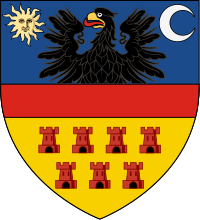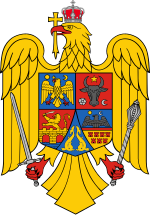Flag and coat of arms of Transylvania
| Historical coat of arms of Transylvania | |
|---|---|
 | |
| Adopted | 1659 |
| Shield | Per fess Azure and Or, a fess Gules between in chief an eagle issuant from the division Sable flanked by a sun-in-splendour Or and an increscent Argent, and in base seven towers Gules. |

The first heraldic representations of Transylvania date from the 16th century. One of the predominant early symbols of Transylvania was the coat of arms of Hermannstadt (Nagyszeben, present-day Sibiu) city. In 1596 Levinus Hulsius created a coat of arms for the imperial province of Transylvania, consisting of a shield party per fess, with a rising eagle in the upper field and seven hills with towers on top in the lower field. He published it in his work "Chronologia", issued in Nuremberg the same year. The seal from 1597 of Sigismund Báthory, prince of Transylvania, reproduced the new coat of arms with some slight changes: in the upper field the eagle was flanked by a sun and a moon and in the lower field the hills were replaced by simple towers.[1]
Principality of Transylvania's coat of arms adopted by the Diet on 24 May 1659[2] represents the privileged nations who were subjects of officially accepted religions in the region (Roman Catholics, Calvinists, Lutherans, and Unitarians), while Orthodox Christians (overwhelmingly Romanians; some Ruthenes present in Carpathian Ruthenia), however, were only tolerated. It depicts:
- on a blue background, a black eagle[3][4] or Turul[5][6] facing dexter, with gold bill and red tongue representing the Hungarians.[7] Some authors (like Josef Bedeus von Scharberg and Arthur Arz von Straußenburg) assert that the eagle symbol comes from the coat of arms of Poland.[2]
- the Sun (dexter) and the crescent Moon (sinister) representing the Szeklers.
- a red dividing band (originally not part of the coat of arms).
- seven red towers with black doors in two series (4+3) on a gold background representing the seven fortified cities of the Transylvanian Saxons - the display is connected with German name of Transylvania - Siebenbürgen ("Seven Fortresses").
The red dividing band was used for the first time by Prince Michael I Apafi, and its first variant was featured on gold coins he issued in 1666.
On the coat of arms used after 1765 was the new Grand Principality crown, awarded by Maria Theresa of Austria, and two women supporters representing abundance (dexter) and justice (sinister); the figures were removed in 1848, when Transylvania was reunited with the Kingdom of Hungary (see Revolutions of 1848 in the Habsburg areas). The historical coat of arms was used within the coat of arms of the Hungarian Kingdom from 1867 (after the Ausgleich and until 1949).
See also
External links
References
- ^ Dan Cernovodeanu, Ştiinţa şi arta heraldică în România, Bucharest, 1977, p. 130
- ^ a b http://www.historica-cluj.ro/anuare/AnuarHistorica2011/15.pdf
- ^ https://books.google.com/books?id=ngABAAAAMAAJ&q=%22stema+transilvaniei%22+acvila&dq=%22stema+transilvaniei%22+acvila&hl=en&ei=CopLTqmNFM6g-wal7eSeCQ&sa=X&oi=book_result&ct=result&resnum=2&ved=0CC0Q6AEwAQ
- ^ https://books.google.com/books?id=6pVnAAAAMAAJ&q=%22coat+of+arms+of+transylvania%22+eagle&dq=%22coat+of+arms+of+transylvania%22+eagle&hl=en&ei=iatLTvTaMeXh4QTC0s3BCg&sa=X&oi=book_result&ct=result&resnum=7&ved=0CEEQ6AEwBg
- ^ Louis Craig Cornish, Transylvania, the land beyond the forest, Dorrance & company, 1947 p. 23
- ^ Michael Kosztarab, Transylvanian roots: the true life adventures of a Hungarian-American, Pocahontas Press, 1997, p. 43
- ^ Ströhl, Hugo Gerard (1890). Oesterreichish-Ungarische Wappenrolle (PDF). Vienna: Verlag von Anton Schroll & C°. p. XV. Retrieved 24 November 2011.
Das Wappen entstand aus den Wappenbildern der magyarischen, sächsischen und der Széklernation. Die Siebenbürger Magyaren erhielten unter dem Fürsten Akusius Barcsay am 24. Mai 1659 (Landtag zu Mühlbach) ein eigenes Siegel: Einen auf einer Wiese stehenden, aufflatternden Adler mit der Umschrift: »Sigillvm Comitatum Transilvaniae«. (The coat of arms was formed from the crests of the Magyar, Saxon and Szekler nations. The Transylvanian Magyars received an own seal under Prince Akusius Barcsay on 24 May 1659 at the Diet of Mühlbach: a fluttering eagle standing on a field, with the inscription »Sigillvm Comitatum Transilvaniae«.)
{{cite book}}: line feed character in|quote=at position 142 (help)

